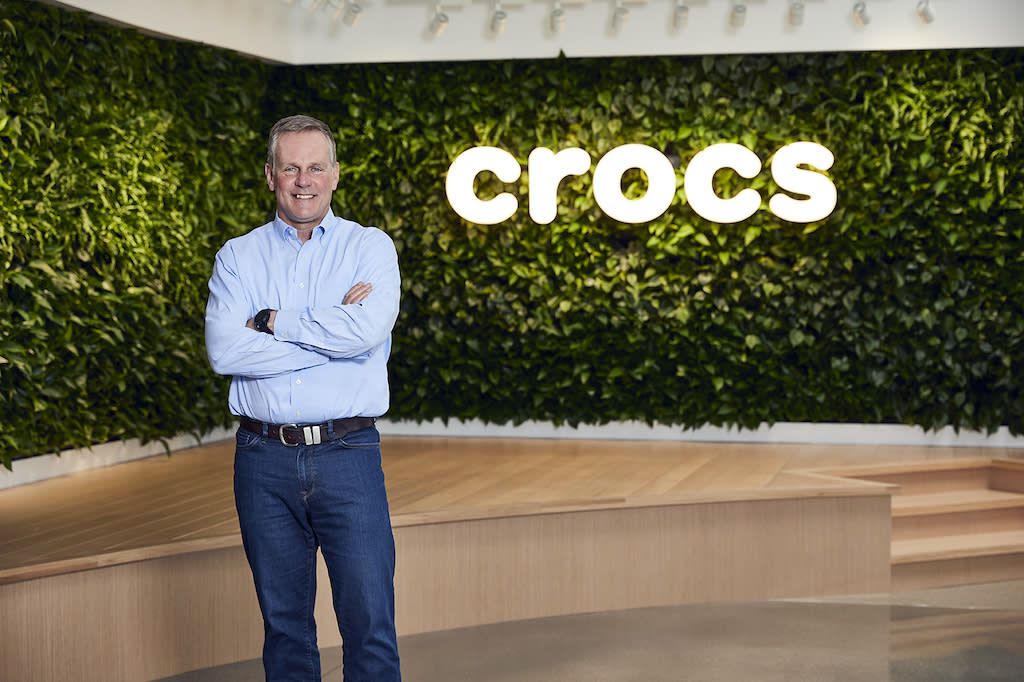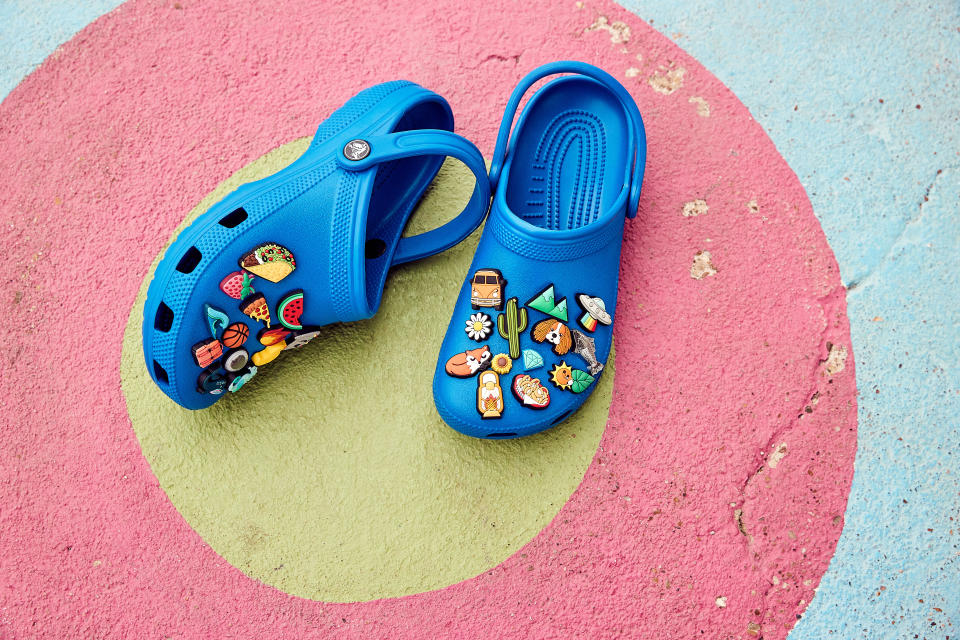Crocs CEO Andrew Rees on Leading the 20-Year Old Brand in Its New Stage of Growth

Crocs has come a long way.
From its origins as a boating shoe that debuted at the Fort Lauderdale International Boat Show in 2002 to teaming with celebrities such as Justin Bieber and Priyanka Chopra, the company has transformed itself more than once. In the last 20 years, Crocs have been defined as a boat shoe, a controversial clog and now a major statement in the high-fashion world.
More from Footwear News
This evolution didn’t happen overnight.
After going public in 2006, the company hit a period of overdistribution and overpenetration just in time for the financial crisis of 2008. Business slowed, new management was brought in, and the company got back on track with a focus on international expansion and right-sizing business in the U.S.
Around 2014, revenues had picked up significantly but profitability was still lagging. That’s when the company got a major investment from Blackstone. That same year, Andrew Rees joined as president, later to rise to CEO in 2017. Crocs then entered a period focused on shifting the product strategy, cutting costs and shaping a new marketing message.
“What makes Crocs such a strong brand is that they are supremely confident in their unique product concept and what they bring to the table,” said Kathy Forstadt, senior director of merchandising at Zappos. “They know who they are, and they find new fun ways to express it with every season, while encouraging others to do the same.”
For his part, Rees told FN his goal since taking the helm has been to change perceptions. “We were known by lots of people, but a lot of people didn’t think it was for them. So it was all about creating brand relevance,” he said.
That strategy has persisted in recent years, sharpening throughout the pandemic and culminating in the brand’s recently announced goal to achieve $5 billion in sales by 2026, which hinges on international growth and digital goals. (As of Q2 2022, Crocs 2022 brand revenues are expected to be $2.545 to $2.615 billion.) Crocs also bolstered its business in a major way last December, when it announced a deal to buy the breakout comfort brand Hey Dude for $2.5 billion.
Here, Rees discusses the evolution of Crocs — and his role guiding the company into its next phase.

Courtesy of Crocs
How has Crocs evolved since it launched 20 years ago, and where does it sit today?
Andrew Rees: “A really good way to frame the evolution of the brand is probably in three phases: the initial entrepreneurial phase, the international expansion phase and then the brand solidification phase. I would say we’re in that final phase. We’ve completed all of that work associated with fixing and professionalizing the business. This is a 20-year anniversary, so that’s not an old company. Now, we’re about halfway through what we see as our immediate growth opportunity. We see some very important global mega-trends around comfort. The consumer wants to be more and more comfortable, particularly relative to footwear but also relative to everything else that they do in their life. They want value to be able to buy that comfort at a reasonable price. And they want style, the right colors and the right patterns. If you can appeal to all those things, you have a lot of growth runway in front of you.”
What was your product strategy when you joined the company?
AR: “The company historically had started to diversify away from the Classic Clog. But we thought that was wrong. So we put our product, graphic and style innovation back into [the silhouette], because that’s the core of the brand. It’s also our most profitable product arena. We refocused on the Classic Clog and almost exclusively on molded product, which is our DNA. That’s what we do best. That’s what nobody else does well and that’s where we could win.”
How are you balancing Classic Clog growth with potential in other categories, like sandals?
AR: “There are still parts of the globe where we’ve got lots of opportunities for Classic Clog penetration, such as in Europe, the Middle East, Africa, Latin America and Asia. But then we also need to complement that. Our overall growth vision is complemented by our focus on sandals. We believe the core DNA of the Crocs brand — around comfort, lightweight, color, fun and inspiration — can apply well in the sandal arena. We think sandals is a very significant growth opportunity — in addition to growth in clogs, not instead of.”
When it comes to distribution, Crocs is aiming for 50% of revenue to come from digital channels by 2026. How do retail partners and stores fit into this strategy?
AR: “We want to be a digital-first company because that’s the consumer trend. And it’s also highly profitable. But the second most important channel is wholesale. We sell to a lot of different types of people. We want to work closely with our wholesale partners here in the U.S. and around the globe, because they use their capital to develop all of these really compelling stores, and we want to be sold in those stores. We’re not one of these brands who’s going to go DTC more and more. We think wholesale is a critically important component. Our direct stores also have a very specific role to play. More than half of our stores are outlet stores and that’s critically important to make sure that we can liquidate end-of-line goods. But also, it’s a very profitable shopping environment. Costs are lower in the outlet malls and the traffic is very high.”
How are you feeling about the goal to achieve $5 billion in sales by 2026, given recent economic headwinds?
AR: “We feel really good about that goal. I think we’re right on track. We’re gaining market share. And if there is a recession or the consumer continues to tighten, we’re also optimistic about our chances in that environment as well because our price point is $50. It’s not $150. So we give the consumer an opportunity to refresh their wardrobe and buy something new at a very approachable price point. We think in a constrained consumer environment, we continue to gain market share.”
How did you decide to purchase the Hey Dude brand earlier this year? Are you pursuing similar acquisitions?
AR: “Hey Dude was a brand we were watching for some time because they were developing and delivering some great product. We thought the comfort value they were aiming for was something we could do at Crocs. And we saw a lot of benefits to the Crocs shareholders. So we went ahead and did it. We’re super excited with the prospects that we see for the Hey Dude brand and we think it is a very strong complement to Crocs. Would we do [another big acquisition] again in the future? Maybe? I’m not saying no. But we’ve got a lot of work on our plate right now to double the size of the Crocs brand and also realize the full potential of Hey Dude. Our immediate focus is the complete integration of Hey Dude, developing that growth platform and continuing to grow Crocs.”
Financial targets aside, what is your aspirational goal for Crocs?
AR: “Historically, a majority of people would describe the Crocs brand as a niche and somewhat polarizing choice. Some people love it, some people hate it. As we move forward, I would like to see Crocs become a mainstream casual comfort brand that is accepted by a much broader segment of society. But [we know it’s not always for] everybody. Actually, it’s pretty valuable to have a group of people that don’t like you because it
creates brand tension. I’d like Crocs to become a mainstream casual comfort brand that has a broad portfolio of products and essentially something for everyone.”
Best of Footwear News
How Shaquille O'Neal Owns a Portion of Elvis Presley's Royalties
Black Fashion Leaders Spotlight the Rising Stars You Need to Know
Marc Jacobs, Kim Kardashian & More Honor Late Fashion Icon André Leon Talley
Sign up for FN's Newsletter. For the latest news, follow us on Facebook, Twitter, and Instagram.

